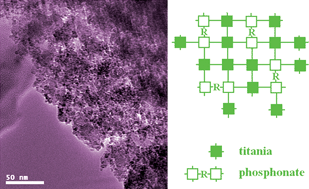Organic–inorganic hybrid materials of porous titania–phosphonate were synthesized using organically bridged tetra- or penta-phosphonates. Claw molecules of ethylene diamine tetra(methylene phosphonic acid) and diethylene triamine penta(methylene phosphonic acid) were anchored to the titania network homogeneously. The synthesized titania–phosphonate hybrids possess irregular mesoporosity formed by the assembly of nanoparticles in a crystalline anatase phase, revealed by the measuement of X-ray diffraction, nitrogen adsorption, scanning and transmission electron microscopy. The structure and chemical states of the materials were characterized by chemical analysis, FT-IR, MAS NMR, XPS and thermogravimetric analysis, revealing the integrity of organic groups inside the framework. The optical properties, catalysis and adsorption performances were also investigated. These porous titania–phosphonate materials exhibited high photocatalytic activity in photodecomposition of Rhodamine B dye molecules whether under UV or visible-light irradiation, and a large capacity for selective adsorption of Cd(II) ions, making them promising adsorbents and photocatalysts for practical applications including wastewater cleanup.

You have access to this article
 Please wait while we load your content...
Something went wrong. Try again?
Please wait while we load your content...
Something went wrong. Try again?


 Please wait while we load your content...
Please wait while we load your content...